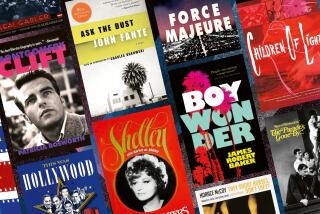Some Links to Golf History, Culture
- Share via
An editor of an anthology is like the guy in the wire-mesh cage on the tractor that picks up golf balls at a driving range: Everybody feels free to take a shot at him.
David Owen, who writes on golf for the New Yorker, genially accepts his and Joan Bingham’s role as human targets in his introduction to this collection of 45 articles and stories, subheaded “The Players,” “The Idiosyncratic Nature of Golf,” “Fiction” and “Covering the Game.”
“So much has been written about golf that any sampling shorter than the Bible is likely to seem arbitrary,” Owen says, adding that because “ ‘Lure of the Links’ is unlikely to be the only golf collection on the reader’s bookshelf . . . we’ve tried to favor the unfamiliar without entirely ignoring the already celebrated.”
In fact, however, Owen and publishing executive Bingham seem to have tried to assemble a book that, in a pinch, could be the only golf collection on the shelf.
Why else reprint pieces as well known and frequently anthologized as John Updike’s “Farrell’s Caddie” and Dan Jenkins’ “The Glory Game at Goat Hills”? Why mingle the genuinely classic golf reportage of Bernard Darwin and Herbert Warren Wind with snippets from Harvey Penick’s recent bestsellers and the latest press bulletins on Tigermania? Why include Marcia Chambers’ articles on women’s battle against country-club sexism--significant journalism but hardly “great writing.”
For that matter, if the editors saw fit to include a trifling story by Stephen Leacock, why isn’t there anything by P.G. Wodehouse? Why don’t we get more than a taste of Arnold Haultain’s 1910 philosophical treatise “The Mystery of Golf”? Why only three paragraphs of Michael Murphy’s “Golf in the Kingdom”?
*
Grumble, grumble. Meanwhile, the guy in the tractor drives on unperturbed as our shots bounce off the wire cage. He gathers up the balls that we will pay good money to hit at him again--just as Owen and Bingham doubtless knew that even the veteran golfers and readers among us will find, rummaging among these mud- and grass-stained pieces of writing, more than a few keepers.
Gene Sarazen memorializes the caddie who helped him win the 1932 British Open. Bobby Jones celebrates the excellence of Joyce Wethered, the best woman golfer of his era, the 1920s. In an alien-free report from Roswell, N.M., in 1973, Sarah Ballard alerts us to the existence of a 16-year-old phenom named Nancy Lopez. In 1962, Henry Longhurst allows that Jack Nicklaus may have made a good career move by turning pro.
Thomas Boswell discusses the dreaded “Choke Factor,” the effects of pressure on golfer’s nerves. John Paul Newport reports on the bargain-basement glory of life on the Florida mini-tours. Co-editor Owen, in “Grown Men on Spring Break,” envisages a monastery where guys could concentrate exclusively on golf and make beer in the evenings. Wind describes the Old Course at St. Andrews in the 1950s, when the green fee was only about 50 cents and tourists hadn’t yet overrun the place.
Some of the best pieces in “Lure of the Links” are in the fiction section, by authors not known for writing on golf. Ethan Canin, in “The Year of Getting to Know Us,” uses golf as a symbol of the ruthless, adulterous world to which a doctor is introducing his teenage son. “You don’t have to get to know me,” the father says, “because . . . you’re going to be me.” Ward Just, in “The Dogleg on 5,” uses a tricky golf hole as a symbol of political corruption.
One of the selling points of golf has long been that many of its champions have also been attractive personalities. Exhibit A is Jones, who for decades uncomplainingly endured the painful spinal disease that killed him in 1971.
In “The Last Days of Bobby Jones,” Charles Price tells how he found excuses to light Jones’ cigarettes for him because Jones had grown too weak even to flick his lighter. Jones’ posthumous gift to Price was the lighter, along with a note: “You weren’t fooling me a bit.”
More to Read
Go beyond the scoreboard
Get the latest on L.A.'s teams in the daily Sports Report newsletter.
You may occasionally receive promotional content from the Los Angeles Times.










